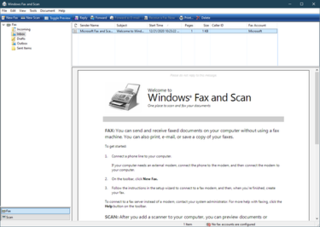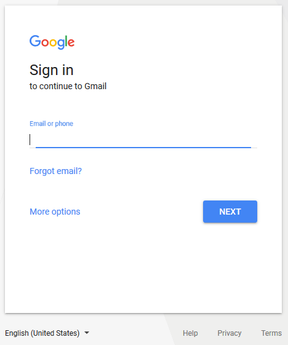Related Research Articles

A message is a discrete unit of communication intended by the source for consumption by some recipient or group of recipients. A message may be delivered by various means, including courier, telegraphy, carrier pigeon and electronic bus. A message can be the content of a broadcast. An interactive exchange of messages forms a conversation.

Instant messaging (IM) technology is a type of online chat allowing immediate transmission of messages over the Internet or another computer network. Messages are typically transmitted between two or more parties, when each user inputs text and triggers a transmission to the recipient(s), who are all connected on a common network. It differs from email in that conversations over instant messaging happen in real-time. Most modern IM applications use push technology and also add other features such as emojis, file transfer, chatbots, voice over IP, or video chat capabilities.

Microsoft Outlook is a personal information manager software system from Microsoft, available as a part of the Microsoft 365 software suites. Though primarily being popular as an email client for businesses, Outlook also includes functions such as calendaring, task managing, contact managing, note-taking, journal logging, web browsing, and RSS news aggregation.
A voicemail system is a computer-based system that allows people to leave a recorded message when the recipient is unable to answer the phone. The caller is prompted to leave a message and the recipient can retrieve said message at a later time.

Gmail is an email service provided by Google. As of 2019, it had 1.5 billion active users worldwide, making it the largest email service in the world. It also provides a webmail interface, accessible through a web browser, and is also accessible through the official mobile application. Google also supports the use of third-party email clients via the POP and IMAP protocols.
Apple Open Collaboration Environment (AOCE) is a collection of messaging-related technologies introduced for the Classic Mac OS in the early 1990s. It includes the PowerTalk mail engine, which is the primary client-side interface to the system, the PowerShare mail server for workgroup installations, and a number of additional technologies such as Open Directory, encryption, and digital signature support.

An adapter in regard to computing can be either a hardware component (device) or software that allows two or more incompatible devices to be linked together for the purpose of transmitting and receiving data. Given an input, an adapter alters it in order to provide a compatible connection between the components of a system. Both software and hardware adapters are used in many different devices such as mobile phones, personal computers, servers and telecommunications networks for a wide range of purposes. Some adapters are built into devices, while the others can be installed on a computer's motherboard or connected as external devices.
BlackBerry Enterprise Server designates the middleware software package that is part of the BlackBerry wireless platform supplied by BlackBerry Limited. The software plus service connects to messaging and collaboration software on enterprise networks to redirect emails and synchronize contacts and calendaring information between servers, desktop workstations, as well as mobile devices. Some third-party connectors exist, including Scalix, Zarafa, Zimbra, and the Google Apps BES Connector, although these are not supported by BlackBerry Limited. As of June 2018, BlackBerry Enterprise Server has been renamed to BlackBerry Unified Endpoint Manager (UEM).

Windows Fax and Scan is an integrated faxing and scanning application introduced in Windows Vista and included in the Business, Enterprise, and Ultimate Windows Vista editions as the replacement for the Fax Console of Windows XP; it is available in all versions of Windows 7, Windows 8, Windows 10 (x86/x64) and Windows 11 (x64), but not on ARM64 versions of Windows 10 and Windows 11.
Unified voicemail is the combination of different voicemail bearers into a single voicemail system. Using dedicated DID /DDI numbers for each mailbox, the mailbox can be used on a variety of devices and end-points. This is similar to what GSM providers use for their voicemail systems. Mobile phones and traditional analog phones need to support conditional call diversion to enjoy unified voicemail. Unified voicemail can be extended into unified messaging as already used.
Unified communications (UC) is a business and marketing concept describing the integration of enterprise communication services such as instant messaging (chat), presence information, voice, mobility features, audio, web & video conferencing, fixed-mobile convergence (FMC), desktop sharing, data sharing, call control and speech recognition with non-real-time communication services such as unified messaging. UC is not necessarily a single product, but a set of products that provides a consistent unified user interface and user experience across multiple devices and media types.

Outlook.com, formerly Hotmail, is a free personal email service offered by Microsoft. This includes a webmail interface featuring mail, calendaring, contacts, and tasks services. Outlook can also be accessed via email clients using the IMAP or POP protocols.
This list is a comparison of web conferencing software available for Linux, macOS, and Windows platforms. Many of the applications support the use of videoconferencing.
Objectworld Communications Corp., formerly ObjectWorld Inc, was a privately held company that provides unified communications software to small- and medium-sized businesses. Objectworld was acquired by Huntsville, Alabama-based ADTRAN Inc.

The Gmail interface makes Gmail unique amongst webmail systems for several reasons. Most evident to users are its search-oriented features and means of managing e-mail in a "conversation view" that is similar to an Internet forum.
The Unified Communications Interoperability Forum (UCIF) is a non-profit alliance between communications technology vendors. It was announced on May 19, 2010, with the vision to maximize the interoperability of UC based on existing standards. Founding members of UCIF were HP, Microsoft, Polycom, Logitech / LifeSize Communications, and Juniper Networks. On July 28, 2014, UCIF merged with International Multimedia Telecommunications Consortium (UMTC) into one consortium.
Callware Technologies, Inc. (Callware) is a software company in the telecommunication industry, headquartered in Salt Lake City, Utah. It specializes in developing unified communication and unified messaging solutions for the US Department of Defense, government, educational institutions, and mid to enterprise business.

Mailbird is a desktop email client for Microsoft Windows, compatible with Windows 7 and all later versions. As well as sending and receiving emails, Mailbird includes managing calendar events and contacts from different email providers, social media, task management, file share, and video-conferencing integrations. Mailbird is offered via paid subscription, but also includes a free version.

Fuze is a cloud communications and collaboration software platform designed for the enterprise. Fuze was acquired by 8x8. The company is headquartered in Boston, Massachusetts.
Unified communications (UC) management is essentially the management of unified communications; it refers to the systems used by enterprise organizations to automate their enterprise communications services and the voice network infrastructure that those services run over.
References
- ↑ "Unified Messaging. Definition and Overview". International Engineering Consortium. 2005. Archived from the original on November 10, 2008. Retrieved 2009-04-02.
- ↑ Kostek, Jessica (2009-02-25). "Frost & Sullivan: Unified Messaging to Become Ubiquitous Enterprise Communication Solution". TMCnet.com. Archived from the original on 2009-02-27. Retrieved 2009-04-07.
- ↑ PC Magazine Unified Messaging definition The Computer Language Company Inc. Archived 2012-09-13 at archive.today
- ↑ Freund, Jesse. "Hype List". Wired. ISSN 1059-1028 . Retrieved 2024-01-30.
- ↑ Art Rosenberg and UCStrategies, "Don't Miss the 'Unified Messaging' Boat in UC Archived 2018-01-15 at the Wayback Machine
- ↑ "What is unified communications?". uctoday. 2018-07-28. Retrieved 2024-01-30.
- ↑ "Hosted vs. On-site Unified Communications: Both Provide Advantages". eFax. 6 April 2012. Retrieved 26 January 2014.